Ijraset Journal For Research in Applied Science and Engineering Technology
- Home / Ijraset
- On This Page
- Abstract
- Introduction
- Conclusion
- References
- Copyright
IOT Based Remote Patient Monitoring System
Authors: Prof. Y. A. Thakare, Anuj J Wadurkar, Ritika R Bobade, Gauri G Gurjar, Vaishnavi R Ninghot, Ayushi C Wasekar
DOI Link: https://doi.org/10.22214/ijraset.2024.60487
Certificate: View Certificate
Abstract
A remote monitoring technique that can accurately track human physiological indicators has applications in virtual reality, sports science, medicine, rehabilitation, and surveillance. The majority of systems now in use for tracking bodily parameters in humans need wiring that limits natural movement. In order to get over this restriction, a wearable wireless sensor network that monitors physiological human body characteristics has been built using an accelerometer, a pulse oximeter, a heart-rate sensor, a temperature sensor, and a galvanic skin response sensor. The individual is being tracked wirelessly using his own location. It would be simple to modify this system to watch athletes and young children. Unlike a tethered monitoring equipment, the wireless feature allows the human body to move freely, making the system genuinely portable, quick, and dependable. The portable and the designed sensor node\'s small size makes it simple to attach to the body.
Introduction
I. INTRODUCTION
Due to its numerous applications in fields including sports science, medical science, rehabilitation, and surveillance, tracking human body parameters has garnered a lot of attention recently. Additionally, the scientific and technological community has recently developed a keen interest in wireless sensors and sensor networks. Even while sensor networks have been around for a while, a whole new range of sensor applications has been made possible by the wireless domain. Due to their differences from both conventional wireless networks and computer networks, wireless sensors and sensor networks provide additional problems to be solved, such as limited energy and limited lifespan. The idea is to let the subject be observed in a natural setting. A wearable system must be able to record data in addition to displaying parameters for monitoring outside of the lab. The suggested method makes use of the wireless sensor network idea, in which every sensor node communicates with the coordinator wirelessly using Wi-Fi network protocol. The coordinator serves as a router, enabling internet communication between sensor nodes and end devices, which could be mobile or computers. Accelerometer, temperature, pulse oximeter (SpO2), heart rate, and galvanic skin reaction sensors are possible additions to any sensor node. The sensor nodes are fully untethered and affixed to the human body. Batteries power them. The sensor nodes' lightweight design and compact size make it simple to attach them to the body.
II. LITERATURE REVIEW
Wireless sensor networks are a key element of ubiquitous healthcare (WSN). WSNs are a new technology that has the potential to revolutionize healthcare. By greatly enhancing and expanding the quality of care across a wide range of settings and demographic segments, the WSNs aim to improve people's quality of life. An overview of wireless sensor network applications in healthcare is given in this publication [1]. This document lists the frequency, range standard, and other details of the major wireless technologies, including WLAN, WPAN, WIMAX, and WBAN, that are utilized in medical applications. To improve the efficacy and efficiency of the monitoring system, these wireless technologies are contrasted according to variables including energy usage, security, and routing protocols [2]. In addition to WSNs, the concept of the internet of things, or IoT, was developed; according to this definition, IoT refers to the interconnection of recognizable items connected to the internet for the purpose of sensing and monitoring [3]. Elder Health Parameter Measurement and Device Designs for Ongoing Surveillance The younger generation bears the responsibility of enhancing the quality of life and providing appropriate care for senior individuals at the appropriate time. An electronic device that is compact, easy to use, and simple to monitor elder health parameters continuously is imperative. The threat of deteriorating health and the possibility of skin-related issues, bed sores, etc. are growing more serious every day for patients who are bedridden. This essay examines the conditions associated with aging and the factors that be kept an eye on [4]. The temperature and heart rate of a human subject can be tracked using a Zigbee-Based Wearable Physiological Parameters Monitoring System. An at-risk individual wears an electronic device around their wrist and finger as part of the system. The individual is electronically monitored in his own house using many sensors to measure various vital indicators. To identify falls, an impact sensor has been employed. When the device determines that a person is in medical crisis, it transmits an alarm to a computer-connected reception unit.
This sounds an alarm, enabling assistance to be given to the user [5]. Modern technology that is widely used .It leverages the power line lines that are already accessible, a technique known as power line communication, to save the cost of electrical wiring. The goal of this project is to use a PLC system to transmit biological parameters such as body temperature, respiration rate, and heart rate. [6] A few of the elder care systems listed in [7] keep an eye on the elderly people's activities at home. They incorporate a video system inside senior citizens' homes and keep a close eye on their daily activities there. Nevertheless, none of the old patient's critical parameters are measured by this device. Vital parameter measurement is a must if the elderly person has heart problems of any kind, which are prevalent in people over 60 [8]. In portable devices that are capable of measuring vital indicators like blood pressure, pulse, ECG, movement, and fall detection, such as Calyx (Complete Ambient Assisted Living Experiment). In order to monitor any cases of bedsore in patients who are bedridden, our design can monitor vital parameters, fall detection, and tilt monitoring. Certain devices, like the one in [9], exclusively keep track of fall detection for senior patients based on sensor readings from microphones and accelerometers that are affixed to their bodies. For patients, the system suggested in [10] is appropriate. Elderly people for fall detection and activity tracking, as well as sports athletes for measuring and analyzing workout patterns. [11] This study describes the development of a wearable wireless sensor network that uses accelerometers to measure arm motion in the sagittal plane. The technology makes movements easier and is more user-friendly. The designed sensor node's small size and light weight facilitate a simple connection to the limb. When compared to a goniometer, experimental results demonstrate that the system has good accuracy and response rate.
III ANALYSIS OF PROBLEM
Generally speaking, a range of physiological body parameters—which are typically interdependent—define the condition of human health. Not all of them are as significant and instructive as the others. Furthermore, not all of those factors could be simply and precisely managed because measuring them calls for specialized settings, pricy medical supplies, and equipment. In the process of creating the entire monitoring system, it is necessary to evaluate not only the significance of the monitored parameters but also the measuring techniques and the practicality of their integration into the system. Studies in medicine have demonstrated that the parameters that describe the function of the heart and lungs are the most significant. They accurately depict the state of human health. Furthermore, vital signs such as body temperature, blood oxygen saturation, skin resistance, posture, and mobility are crucial factors in enhancing human performance in domains including sports, virtual reality, rehabilitation, and medicine.
IV. SYSTEM DESIGN & IMPLEMENTATION
A. System Design Architecture
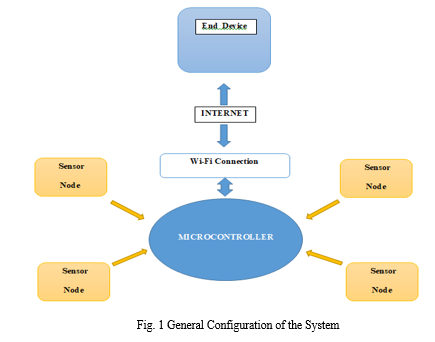
The system configuration is displayed in Fig. 1. The system is seen to be made up of several sensor nodes that connect wirelessly in a star network architecture to a central coordinator. A promising subject called wireless sensor networks combines wireless communication, embedded systems, and sensor technologies to create compact, dependable systems that can monitor particular occurrences at a cheap cost and power. The wireless protocol suite was chosen for this system due of its end-to-end connection. The coordinator serves as a router, enabling internet communication between sensor nodes and end devices, which could be mobile or computers. An accelerometer, temperature sensor, pulse oximeter (SpO2), heart-rate sensor, and galvanic skin response sensor may be installed on each sensor node. The sensor nodes are fully untethered and affixed to the human body. Batteries power them.
B. Functional Block Diagram Of System Design

The system's functional block diagram is displayed in Fig.2. The system is intended to receive multiple inputs from sensors that measure physiological parameters of the human body, such as a temperature sensor to measure body temperature, an accelerometer to detect body position, muscle movement, and motion, a SPO2 sensor to monitor blood oxygen level and heart rate, and a galvanic skin response sensor to measure skin response. The microcontroller integrates and processes the sensor inputs before sending the processed data to a Wi-Fi IoT device. With the assistance of an internet coordinator, the IoT device forwards data received from the microcontroller to the end device, which is a computer. At this point, we are able to monitor all the parameters on the IOT platform that is operating on the end device. The coordinator, which might be a modem or Wi-Fi mobile, serves as a router. Data on the IoT platform (Thinger.io) is automatically updated as the sensor node is linked to the host computer. Because of the modular design, adding more sensors to measure and track different characteristics is a fairly simple and straightforward process.
V. PARAMETERS TO BE MONITORED
The system monitor numbers of body parameters at a time matters a lot while designing it.
A. Body Temperature
One fundamental parameter that every person needs to be aware of is their body temperature. The primary coordinator receives the temperature reading from a body temperature sensor that is positioned at a specific spot on the body. In addition to being one of the most crucial physiological markers during exercise, body temperature can also be utilized to identify the warning indications of heat exhaustion and heat stroke. Exercise requires careful monitoring of body temperature because heat stroke can happen if it rises above 40 °C.
B. Body Postural Movements
Tracking the human body's movements is crucial for a number of applications, such as sports, physical education, and medical. For the purpose of assessing and treating balance and gait disorders in rehabilitation, physical therapists must be able to detect motion using inertial sensors, which requires constant monitoring of activity and movement. Fall detection is one of the major issues pertaining to the elderly. Falls are frequently linked to substantial morbidity and can be indicators of ill health and deteriorating function. Falls are the cause of more than 90% of hip fractures, and people over the age of 70 account for the majority of these fractures. So, keeping an eye on elderly people who are bedridden becomes extremely important for preserving their health.
C. Heart Rate and Blood Oxygen
Another fundamentally significant human characteristic is the hart rate. Hypertension, or high blood pressure, is frequently associated with illnesses including heart attacks and strokes.Professional trainers, club athletes, and fans of cardiovascular sports like cycling, swimming, and running have all made extensive use of heart-rate monitors in sports to enhance athletic performance. Healthcare practitioners frequently utilize blood oxygen saturation as a tool to screen for disorders including anemia or cardiac problems. A heart that pumps inadequately is a big problem in the senior society. Since all of the arteries and nerves get weaker, the heart's overall activity decreases. Over 65-year-olds account for over 83% of heart disease deaths. Therefore, it is necessary to incorporate the heart rate monitoring.
D. Galvanic Skin Response
The skin resistance (G) is determined by the thickness of the stratum corneum, chemicals, vasoconstriction and relaxation, skin humidity, and the GSR sensor, which detects changes in the skin's surface resistance by discharging a current into the body. Therefore, the skin resistance value drops when someone is uncomfortable or has a change in mood. As a result, the rate of change in GSR can be used as a heat stroke evaluation index.
VI. SYSTEM DESIGN CONFIGURATION

According to the system configuration depicted in Figure 4.4, the system is made up of several sensors, including an accelerometer (ADXL 345) for measuring postural and motion of the body in terms of tilt angle of up to three axes, a SPO2 MAX30100 for measuring heart rate and blood oxygen level, a 10K thermistor for temperature detection, and a GSR for measuring skin resistance. These sensors all use two to four wire connections to communicate with the Arduino Nano board. The accelerometer ADXL345 and the SPO2 MAX 30100 sensor module are digital sensors, and as such, they communicate with the microcontroller via Inter-Integrated Circuit (I2C: SCL, SDA) logic. The Arduino Nano Board module has an ATmega328 microcontroller. Thermistor and GSR sensors, on the other hand, are analog sensors, therefore they connect with the microcontroller via the analog input lines (A0 and A1). With the aid of the Tx & Rx line, the microcontroller AT mega 328 interprets the data it receives from the various sensors and sends the processed data serially to the Node MCU ESP8266 Wi-Fi Module. The Node MCU's Wi-Fi connectivity capability enables connections to be formed with a mobile phone or Wi-Fi modem, which is the system's coordinator device. Finally, Thinger.io, an IoT platform, enables the monitoring of human body parameters from various sensor nodes on the end device, i.e., computer or mobile, with the assistance of coordinator node McUESP8266, which helps deliver all the data to the end device via internet. The 5-V rechargeable alkaline battery may be utilized by the sensor node.
A. About Arduino Nano
Based on the ATmega328 microprocessor, the Arduino Nano is a compact, feature-rich, and breadboard-friendly board (Arduino Nano 3.0). With a different packaging, it offers nearly the same capabilities as the Arduino Duemilanove. It only loses a DC power jack and uses a Mini-B USB cable rather than a regular one. Gravitech is the company that invented and manufactures the Nano.
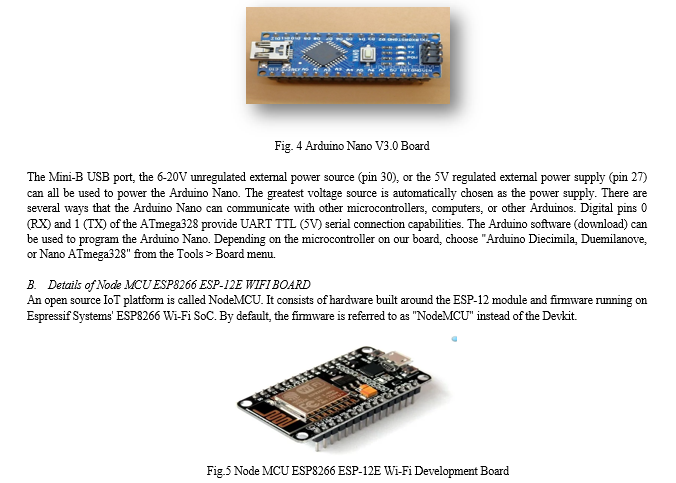
ESP8266EX, sometimes known as ESP8266, is a system-on-a-chip (SoC) that condenses a 32-bit Tensilica microprocessor together with filters, power management modules, antenna switches, RF baluns, standard digital peripheral interfaces, power amplifiers, and low noise receive amplifiers into a compact package. Wi-Fi (802.11 b/g/n, supporting WPA/WPA2) at 2.4 GHz, 16 GPIO general-purpose input/output, Inter-Integrated Circuit (I²C), 10-bit analog-to-digital conversion, ESP8266.net — the Internet of Things with ESP8266 UART (on dedicated pins, plus a transmit-only UART can be enabled on GPIO2), and pulse-width modulation (PWM) are among its features. The CPU core, dubbed "L106" by Espressif, operates at 80 MHz (or can be overclocked to 160 MHz) and is based on Tensilica's Diamond Standard 106 Micro 32-bit processor controller core.
C. Details Of Sensing Devices
Four sensors make up the present version of the system: a temperature sensor, a galvanic skin response sensor, a pulse oximeter (SpO2 and heart rate sensor), and an accelerometer. The ADC (Analog-to-Digital) inputs of the microcontroller receive analog voltage generated by the circuitry employed in the design of the temperature and GSR sensors, which are analog sensors. The accelerometer and SpO2 sensor are digital sensors. Different rates of sampling and time-multiplexing are applied to the ADC input. Below is a description of each unique sensor.


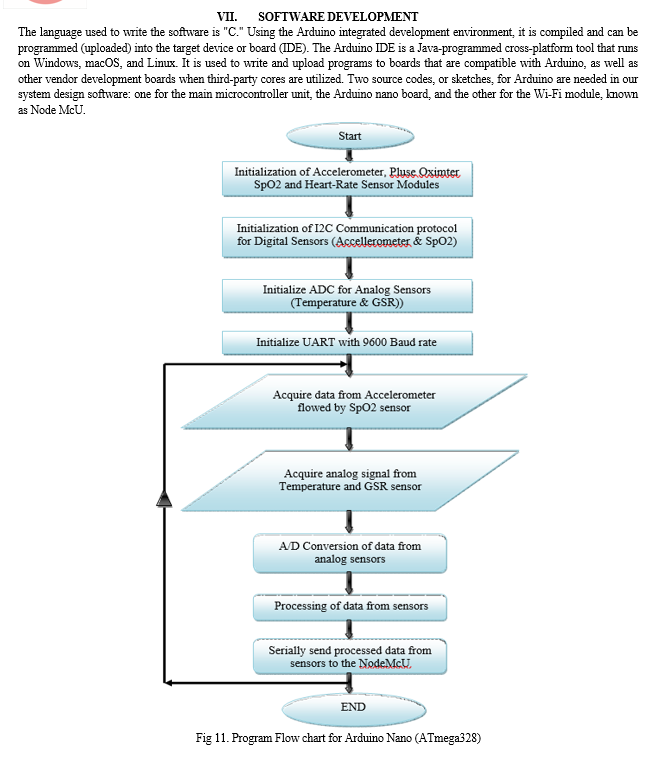
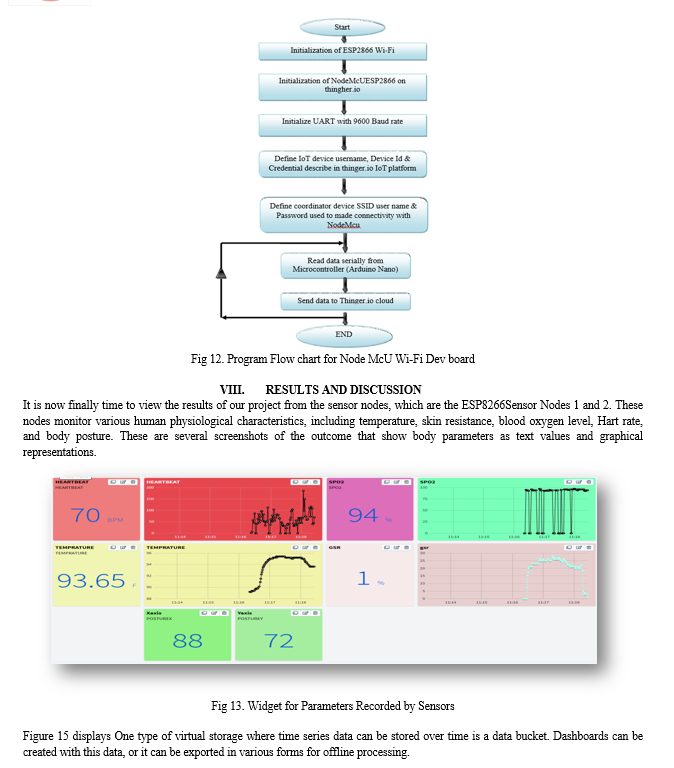
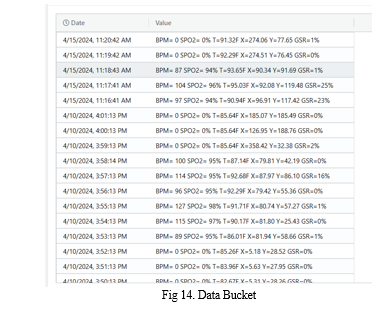
IX. APPLICATIONS
A. Medical science
Patient observation while receiving physical treatment and patient monitoring.
B. Sports science
For the examination of sports rehabilitation drills. Acknowledging physical activity and their levels of intensity.
C. For Military
With this project, we can monitor soldiers to learn about their daily activities and use a database to improve soldiers' health and overall military performance.
X. FUTURE SCOPE
Miniaturization was a key component of the design in order to make the system as unobtrusive as possible for the wearer. In our project, "Monitoring of Human Body Parameters using Wearable Wireless Sensor Network," the hardware portion of the system design is the sensor node, which includes digital and analog sensors, an Arduino nano board, and node McU Wi-Fi modules. This was accomplished by utilizing nano boards with ultra low power operating devices and wearable sensor modules, which extend the wearable sensor node's battery life.
Conclusion
Based on a wearable wireless sensor network, a novel method for remote measurement and monitoring of human body parameters has been introduced. All of the human body\'s parameters can be efficiently measured and tracked by the suggested system. Wearable sensors and the Wi-Fi standard wireless communication protocol are used by the system to convey data between the coordinator and sensor node. Effective monitoring of all human body characteristics on an IoT platform is made possible by the coordinator, which permits data transfer from sensor nodes to the IoT cloud environment.
References
[1] Matthew N. O. Sadiku, Kelechi G. Eze, Sarhan M. Musa, “Wireless Sensor Networks for Healthcare” JSAER, Vol. 5, Issue 4, April 2018. [2] M.Logambal, Dr.V.Thiagarasu,, “A Survey on Wireless Sensor Networks in Human Healthcare Monitoring System” IJIRCCE, Vol. 5, Issue 4, April 2017. [3] Mustafa Kocakulak and Ismail Butun, “An Overview of Wireless Sensor Networks Towards Internet of Things” IEEExplore 978-1-5090-4228-9/2017. [4] R K Megalingam, Goutham Pocklassery, Galla Mourya, Ragavendra M Prabhu, “Measurement of Elder Health Parameters and the Gadget Designs for Continuous Monitoring” 3rd International Conference on Advancements in Electronics and Power Engineering (ICAEPE\'2013) January 8-9, 2013 Kuala Lumpur (Malaysia) [5] Karandeep Malhi, Subhas Chandra Mukhopadhyay,, “A Zigbee-Based Wearable Physiological Parameters Monitoring System” IEEE sensors journal, vol. 12, no. 3, march 2012. [6] Pramodkumar S, Rajendra Chincholi, “Realization of Biomedical Parameters of Human body and its monitoring using power line communication technology” Proceedings of SARC-IRAJ International Conference, 16th June 2013, Pune, India, ISBN: 978-81-927147-8-3 [7] Zhongna Zhou, Wenqing Dai, Jay Eggert, Jarod T. Giger,“A Realtim System for In-home Activity Monitoring of Elders”, 31st Annual International Conference of the IEEE EMBS Minneapolis, Minnesota, USA, September 2-6, 2009, Digital Object Identifier: 10.1109/IEMBS.2009.5334915 . [8] Doukas, C. Samos Maglogiannis, “Advanced patient or elder fall detection base on movement and sound data” Proceedings of the 2nd International Conference on Pervasive Computing Technologies for Healthcare 2008, Page: 103 – 107. Digital Object Identifier: 10.1109/PCTHEALTH.2008.4571042. [9] Young bum Lee Yonsei Univ, “Implementation of Accelerometer Sensor Module and Fall Detection Monitoring System based on Wireless Sensor Network”, Engineering in Medicine and Biology Society, 2007. EMBS2007. 29th Annual International Conference of the IEEE, 22-26 Aug. 2007, Page:2315 – 2318.Digital Object Identifier: 10.1109/IEMBS.2007.4352789. [10] A.Dasthagiraiah, N.Viswanadham & K.Venkateswarlu “Patient Monitoring By Using Wearable Wireless Sensor Networks with Zigbee Module”, International Journal of Computational Engineering Research (ijceronline.com) Vol. 3 Issue. 2. [11] Guo Xiong Lee; Kay Soon Low; Taher, “Unrestrained Measurement of Arm Motion Based on a Wearable Wireless Sensor Network”, IEEE Transactions on vol.59, no.5, pp.1309,1317, May 2010 [12] K. Malhi, “Wireless sensors network based physiological parameters monitoring system,” M.S. thesis, Massey University, Palmerton, New Zealand, 2010.
Copyright
Copyright © 2024 Prof. Y. A. Thakare, Anuj J Wadurkar, Ritika R Bobade, Gauri G Gurjar, Vaishnavi R Ninghot, Ayushi C Wasekar. This is an open access article distributed under the Creative Commons Attribution License, which permits unrestricted use, distribution, and reproduction in any medium, provided the original work is properly cited.

Download Paper
Paper Id : IJRASET60487
Publish Date : 2024-04-17
ISSN : 2321-9653
Publisher Name : IJRASET
DOI Link : Click Here
 Submit Paper Online
Submit Paper Online

